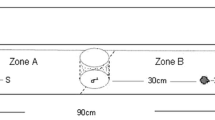Abstract
Natural food odours elicit different behavioural responses in snails. The tentacle carries an olfactory organ, and it either protracts toward a stimulating carrot odour or retraces in a startle-like fashion away from a cucumber odour. The tentacle retraction to cucumber was still present after the snails were fed cucumber during inter-trial periods. Also, snails without any food experience displayed a longer latency to the first bite of cucumber than of carrot and rejected cucumber more often. After tasting these foods, the latency to carrot was not affected while the latency to and number of rejections of cucumber decreased. These results suggest that initial repulsive features of food odour can be only partially compensated by olfactory learning and feeding experience. In the present study, we demonstrated that an invertebrate can be repulsed or attracted by the same natural odour at the same time and that these behavioural responses are likely aimed at achieving different physiologically relevant goals.





Similar content being viewed by others
References
Alexander J Jr, Audesirk TE, Audesirk GJ (1984) One-trial reward learning in the snail Lymnaea stagnalis. J Neurobiol 15(1):67–72
Balaban PM, Bravarenko N (1993) Long-term sensitization and environmental conditioning in terrestrial snail. Exp Brain Res 96:487–493
Benjamin PR, Staras K, Kemenes G (2000) A systems approach to the cellular analysis of associative learning in the pond snail Lymnaea. Learn Mem 7:124–131
Brembs B, Lorenzetti FD, Reyes FD, Baxter DA, Byrne JH (2002) Operant reward learning in Aplysia: neuronal correlates and mechanisms. Science 296(5573):1706–1709
Chase R, Croll RP (1981) Tentacular function in snail olfactory orientation. J Comp Physiol A 143:357–362
Colwill RM, Goodrum K, Martin A (1997) Pavlovian appetitive discriminative conditioning in Aplysia californica. Anim Learn Behav 25:268–276
Croll RP, Chase R (1980) Plasticity of olfactory orientation to foods in the snail Achatina fulica. J Comp Physiol A 136:267–277
Friedrich A, Teyke T (1998) Identification of stimuli and input pathways mediating food-attraction conditioning in the snail, Helix. J Comp Physiol A 183:247–254
Hopfield JJ (1999) Odor space and olfactory processing: Collective algorithms and neural implementation. Proc Natl Acad Sci USA 96:12506–12511
Jones N (2001) The nose and paranasal sinuses physiology and anatomy. Adv Drug Deliv Rev 51:5–19
Keyhani K, Scherer PW, Mozell MM (1997) A numerical model of nasal odorant transport for the analysis of human olfaction. J Theor Biol 186:279–301
Kupfermann I (1974) Feeding behavior in Aplysia: a simple system for the study of motivation. Behav Biol 10(1):1–26
Lemaire M, Chase R (1998) Twitching and quivering of the tentacles during snail olfactory orientation. J Comp Physiol A 182:81–87
Malyshev AY, Balaban PM (2002) Identification of mechanoafferent neurons in terrestrial snail: response properties and synaptic connections. J Neurophysiol 87(5):2364–2371
Nikitin ES, Balaban PM (2000) Optical recording of odor-evoked responses in the olfactory brain of naive and aversively-trained terrestrial snails. Learn Mem 75.6:422–432
Nikitin ES, Zakharov IS, Samarova EI, Kemenes G, Balaban PM (2005) Fine tuning of olfactory orientation behavior by the interaction of oscillatory and single neuronal activity. Eur J Neurosci 22(11):2833–44
Sahley C, Gelperin A, Rudy JW (1981) One-trial associative learning modifies food odor preferences of a terrestrial mollusc. Proc Natl Acad Sci USA 78(1):640–642
Sokolov EN (1963) Perception and the conditioned reflex. Pergammon, Oxford
Straub VA, Kemenes I, O’Shea M, Benjamin PR (2006) Associative memory stored by functional novel pathway rather than modifications of preexisting neuronal pathways. J Neurosci 26(15):4139–4146
Vickers NJ, Christensen TA, Baker TC, Hildebrand JG (2001) Odor-plume dynamics influence the brain’s olfactory code. Nature 401:466–470
White J, Mall S, Kauer JS (2002) Using biology to guide development of an artificial olfactory system. In: Ayers J, Davis J, Rudolph A (eds) Neurotechnology for biomimetic robots. MIT Press, Cambridge, pp 97–113
Zakharov IS, Balaban PM (1987) Neural mechanisms of age-dependent changes in avoidance behaviour of the snail Helix lucorum. Neuroscience 23(2):721–729
Acknowledgments
We are grateful to Prof. George Kemenes for participation in data discussion and to Dr. Richard Boyle for comments on manuscript and editing. The work was supported by RFBR grants to P.B., I.Z., grant MK-2067.2007.4 to E.N. All the experiments comply with the “Principles of animal care”, publication No. 86-23, revised 1985 of the National Institute of Health, and also with the current laws of Russia.
Author information
Authors and Affiliations
Corresponding author
Rights and permissions
About this article
Cite this article
Nikitin, E.S., Korshunova, T.A., Zakharov, I.S. et al. Olfactory experience modifies the effect of odour on feeding behaviour in a goal-related manner. J Comp Physiol A 194, 19–26 (2008). https://doi.org/10.1007/s00359-007-0272-4
Received:
Revised:
Accepted:
Published:
Issue Date:
DOI: https://doi.org/10.1007/s00359-007-0272-4



